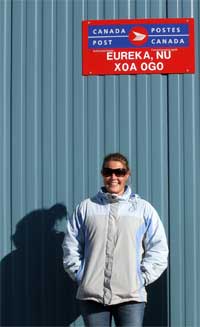 |
| Fourth-year science student Stephanie Flynn in Eureka, Nunavut. (Photo courtesy Stephanie Flynn) |
Some people enter the swimming pool with caution, dipping their toes to gauge the temperature before slowly immersing themselves. Others, like Stephanie Flynn, prefer to jump right in.
Ms. Flynn, a competitive swimmer with DalhousieÕs AUS championship womenÕs team, brings that same philosophy to her work here at Dalhousie. Going into the final year of her physics undergrad, sheÕs spent her summer helping atmospheric scientist James Drummond set up his new laboratory here at Dal almost from scratch. The pinnacle of the experience, though, has been the chance to travel to the top of the world.
Eureka, Nunavut sits at 80¡N and 86¡W, on Slidre Fjord on Ellesmere Island. ItÕs home to CanadaÕs first High Arctic weather station, established in 1947 in a joint project between the United States Weather Bureau and what would eventually become the Meteorological Service of Canada. The station is staffed year-round by researchers scanning the skies for vital scientific insight into global warming, stratospheric dynamics and ozone depletion.
ÒItÕs pretty remote up here Ð weÕre only about 1,100 km from the North Pole,” says Ms. Flynn, writing via email from the arctic outpost. ÒItÕs not too cold up here at this time of year, about 7 or 8 degrees and sunny, but you do feel the chill when the wind picks up. ItÕs actually 24 hours daylight here right now, which is pretty neat but pretty confusing when itÕs time to go to bed.”
Dr. DrummondÕs team flew into Yellowknife on August 11 and took a small charter plane over the arctic glaciers to reach their destination. They spent their first day visiting the three labs that make up the weather station Ð PEARL, 0PAL and SAFIRE Ð but since then have spent most of their time at PEARL collecting data and doing computer maintenance. The data collected measures absorption of various chemical in our atmosphere that play an important role in understanding issues like climate change and global warming.
ÒItÕs research for the greater good, as Dr. Drummond puts it,” says Ms. Flynn. ÒItÕs getting important knowledge about whatÕs happening in our atmosphere and in the skies around the earth.” She returns to Nova Scotia on Wednesday.
This is Ms. FlynnÕs second summer doing lab work here at Dalhousie; last summer she worked with materials science professor Jeffrey Dahn.
ÒI think itÕs important to try out different things at university to see what you like and what youÕre good at,” she explains. ÒTravelling to Eureka has let me see what physics is like out in the field, and how different it is from the lab. I think experiences like these are something to be highly valued, and I feel really lucky to here.”
